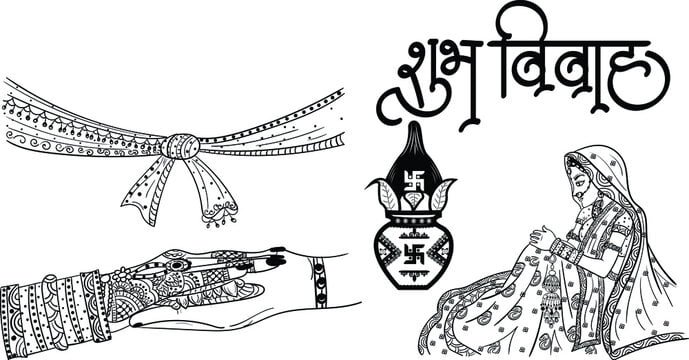Hindu weddings are known for their rich cultural traditions and vibrant celebrations. One of the most significant elements of a Hindu wedding is the invitation card, which often features intricate symbols that hold deep cultural and spiritual meanings.
These symbols not only add aesthetic beauty to the wedding cards but also convey important messages and blessings.
In this blog, we will explore the various types of Hindu wedding card symbols that play a pivotal role in these joyous occasions.
Hindu wedding invitations are a reflection of the cultural and spiritual values that are cherished in the religion.
These invitations are adorned with a variety of symbols that hold deep significance, and each symbol tells a unique story that adds to the grandeur of the occasion.
The Om Symbol (ॐ)
The Om symbol, also known as “Aum,” is a sacred sound and a spiritual icon in Hinduism. It represents the essence of the universe and is often found at the beginning of many Hindu scriptures.
The inclusion of the Om symbol in wedding cards signifies the presence of divine blessings and the auspiciousness of the union.
The Lotus Flower
In Hinduism, the lotus flower symbolizes purity, beauty, and spiritual growth. Just as the lotus rises from the muddy waters to bloom into a beautiful flower, it signifies the journey of the couple’s love and their growth together as they embark on a new chapter of life.
The Peacock Feather
The peacock is a symbol of beauty, grace, and love. In Hindu mythology, the peacock is associated with the deity Lord Krishna and his everlasting love. Including a peacock feather on the wedding card is a way to invoke the blessings of love and devotion upon the couple.
Ganesha – The Remover of Obstacles
Lord Ganesha, the elephant-headed deity, is revered as the remover of obstacles and the god of new beginnings. His presence on a wedding card ensures the removal of any obstacles and challenges that the couple may face as they begin their journey together.
The Conch Shell (Shankha)
The conch shell is a symbol of purity and auspiciousness. It is often blown during religious ceremonies to ward off negative energies. Having the conch shell on the wedding card signifies the couple’s intention to have a pure and harmonious union.
The Swastika
The swastika is an ancient symbol of well-being and prosperity. It represents the cycle of life, and its inclusion on a wedding card signifies the couple’s prayers for a life filled with happiness, good health, and prosperity.
The Kalash (Water Pot)
The kalash symbolizes completeness and abundance. It is often used in Hindu rituals and represents the divine presence. Including the kalash on the wedding card is a way to seek blessings for a fulfilling and prosperous married life.
The Diya (Oil Lamp)
The diya represents the victory of light over darkness. It symbolizes the couple’s hope for a life illuminated by love, wisdom, and positivity. The diya’s flame also signifies the presence of the divine in their journey together.
The Baraat Procession
The baraat is the groom’s grand procession to the wedding venue. It is a joyous and colorful celebration, often accompanied by music and dance. Including the depiction of the baraat on the wedding card sets a festive tone and showcases the couple’s excitement for the upcoming celebrations.
The Mandap
The mandap is the sacred canopy under which the wedding rituals take place. It represents the universe, and its inclusion on the wedding card symbolizes the divine blessings showered upon the couple as they unite in marriage.
The Seven Steps (Saptapadi)
The Saptapadi is a crucial ritual where the couple takes seven steps together, each step signifying a vow they make to support and cherish each other. Including this symbol on the wedding card signifies the couple’s commitment to these vows.
The Red Bindi
The red bindi on a bride’s forehead is a symbol of her marital status and is believed to protect her and her husband’s well-being. Including the red bindi on the wedding card is a way to honor this cultural tradition.
The Mehndi (Henna) Design
Mehndi is a pre-wedding ritual where the bride’s hands and feet are adorned with intricate henna designs. Including a henna motif on the wedding card represents beauty, transformation, and the bride’s preparation for the wedding.
Recommended to read : How to Make a Hindu Wedding Invitation?
FAQs
Are these symbols consistent across all Hindu weddings?
While many of these symbols are commonly used, the choice of symbols can vary based on regional and family traditions.
Can non-Hindu couples use these symbols in their wedding cards?
Yes, these symbols are often appreciated for their beauty and can be used by couples from various cultural backgrounds.
What is the significance of the red color in Hindu weddings?
Red is considered auspicious and symbolizes love, commitment, and fertility in Hindu culture.
Do these symbols have a religious significance only?
While rooted in religious beliefs, these symbols also carry cultural and aesthetic significance.
Can I personalize the symbols on my wedding card?
Absolutely, adding a personal touch to these symbols can make your wedding card even more meaningful..



I was lucky enough to find this phenomenal website recently, a jewel providing value to subscribers. The clever owner really understands how to crank out relevant content. I’m pumped about this find and hopeful the excellent content keeps coming!
Your article helped me a lot, is there any more related content? Thanks!